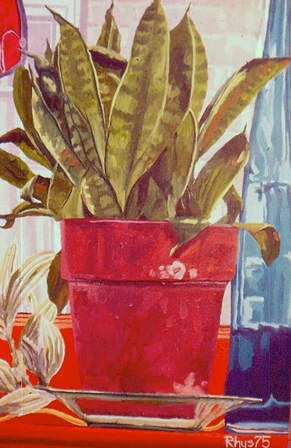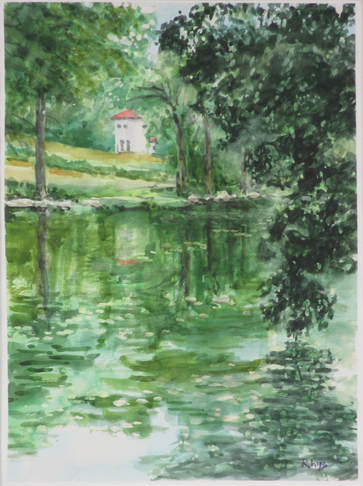There was a bit performed on Saturday Night Live years ago in which Earthmen arrived on a distant planet populated by well-endowed women whose eyeballs were on the tips of their breasts. The well-behaved men addressed the women’s heads when one of the ladies scolded, “Hey! Our eyes are down here, Buster!”
I believe we have been trained to look politely at art with our eyes instead of our breasts, and here I refer to the heart, not the mammary.
I believe we have been trained to look politely at art with our eyes instead of our breasts, and here I refer to the heart, not the mammary.
| I remember being frustrated in art history classes because they dealt in historical facts and stylistic features without getting to feelings, let alone line and color. There are two categories of art discussion: one regards content and the other mechanics. Content is the stuff that the work of art is about--its subject matter and issues related thereto. Mechanics, for want of a better word, refers to the artist's technique in utilizing line, color and composition, etc.--the elements of art. Content can elicit feelings by telling a story--Norman Rockwell comes to mind, as does Sorolla--or by placing the viewer into a scene like one of Andrew Wyeth's interiors. |
But what can send my joy skyrocketing are the connections I feel with artists through their mechanics, their process.
When Picasso's Guernica was in the Museum of Modern Art in New York I used to go and sit in front of it almost every weekend, ready to feel something and failing. I had been taught to value it for its content but I couldn't relate. His Woman in White (at The Metropolitan Museum of Art, which will not allow me to copy the image here) however, rendered me ecstatic, not least of all because he had returned to it after it had dried and wiped a white scumble over it with a rag, perfecting it and leaving a record of that last step. You can't really see that in a print; as with most art, you just don't see it fully unless you stand in front of it.
Matisse's scrubbed-in thin paint, Van Gogh's delicate laying in of one more brushstroke of thick paint, Thiebaud's long fluid strokes following the shape of a piece of cake: these allow us to sense the artist's hand, and that is exciting!
When Picasso's Guernica was in the Museum of Modern Art in New York I used to go and sit in front of it almost every weekend, ready to feel something and failing. I had been taught to value it for its content but I couldn't relate. His Woman in White (at The Metropolitan Museum of Art, which will not allow me to copy the image here) however, rendered me ecstatic, not least of all because he had returned to it after it had dried and wiped a white scumble over it with a rag, perfecting it and leaving a record of that last step. You can't really see that in a print; as with most art, you just don't see it fully unless you stand in front of it.
Matisse's scrubbed-in thin paint, Van Gogh's delicate laying in of one more brushstroke of thick paint, Thiebaud's long fluid strokes following the shape of a piece of cake: these allow us to sense the artist's hand, and that is exciting!
| Too often I forget myself and get a little too literal, a little too tight for my own taste. There are hundreds of artists more illusionistic (realistic) than I, and I do enjoy their work, but for my own work I prefer a wider gap between illusion and awareness of process. When a painting gets too cautious many viewers are happier, but I am less so. When someone asks why I don't like one of my own works as much as they do, I'm not going to talk my own work down; I just say, "It's not quite what I was going for." When someone likes my work for the "right" reasons I am abundantly grateful, and I wish there were many more of you. |
Hey! Look from down here, Buster!


 RSS Feed
RSS Feed